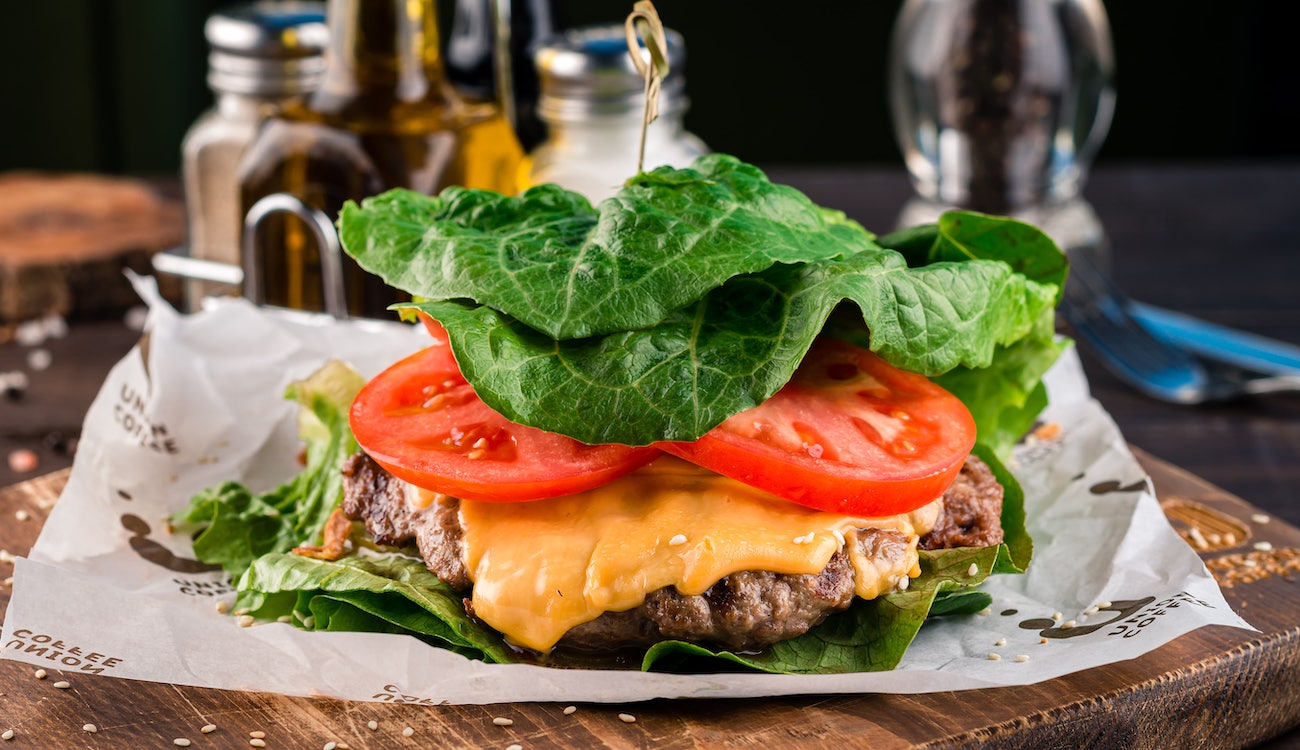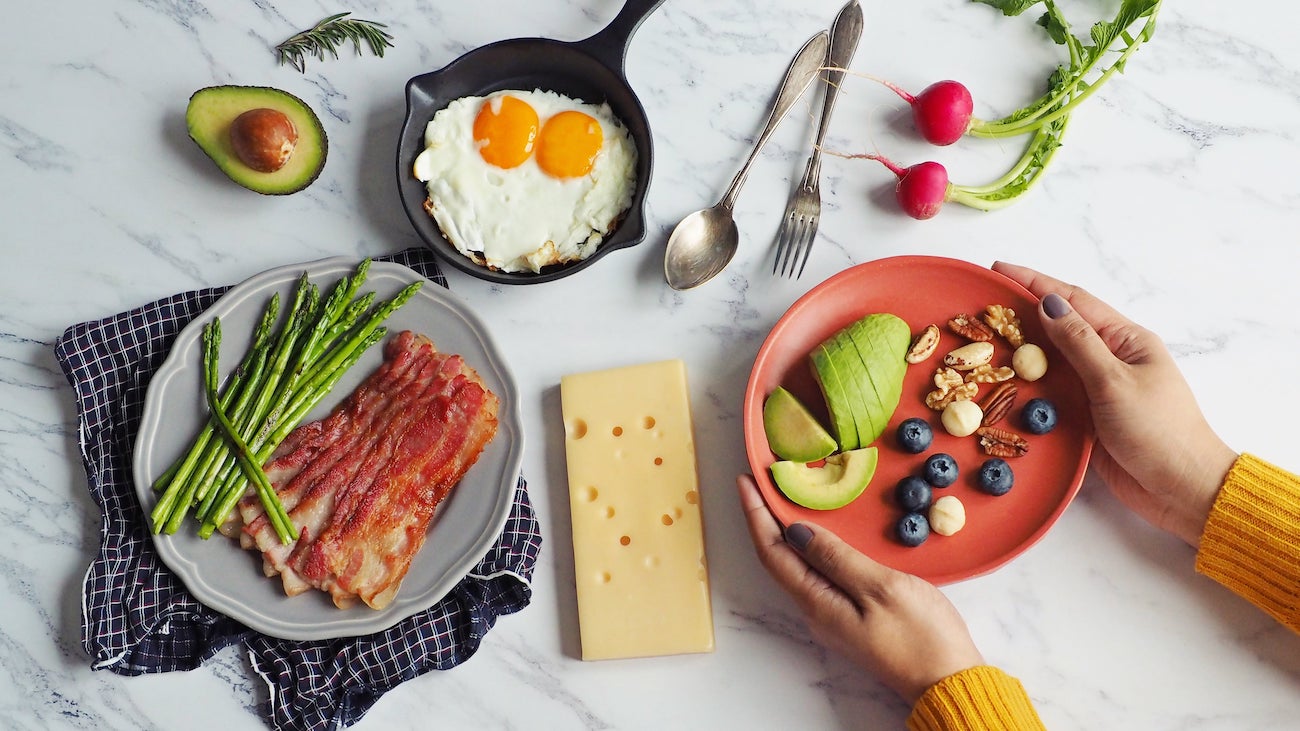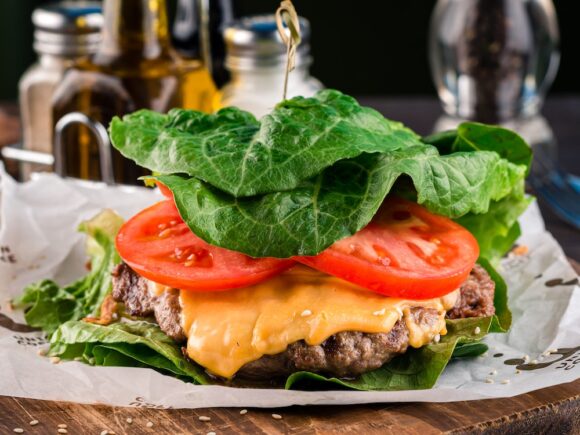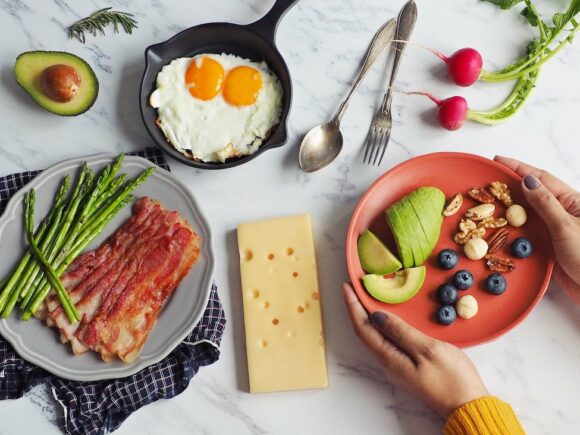Creating a Keto Meal Plan: Why It’s Important and Why You Should Do It on the Keto Diet

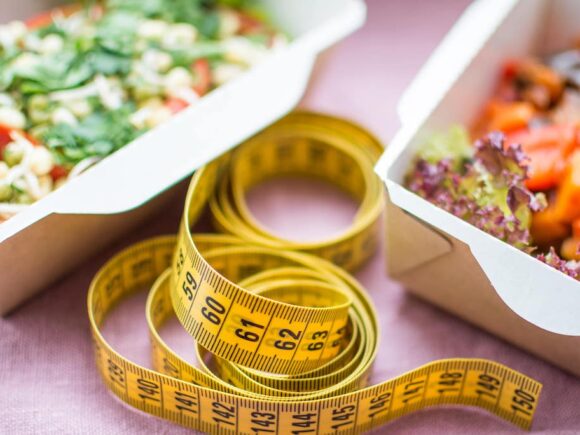
In this article, we’ll explore the ins and outs of meal planning and find out why it’s crucial to plan your meals when you’re following the keto diet. We’ll provide you with practical tips for your first week on keto to help you get started. As an added bonus, we’ll equip you with a keto meal plan for free.
Let’s dive into the world of the keto diet and learn everything you need to know before you create your very own keto meal plan!
What Is Keto?
Keto, also known as the ketogenic diet, is a low-carb, high-fat diet whose main goal is to enable you to achieve ketosis – a metabolic state that shifts the body’s primary source of energy from carbohydrates to fat. This state is achieved by getting most of your daily calories from fats and limiting carb intake.
Following the keto diet has been shown to help people lose weight and improve their blood sugar control. It also shows promise in protecting the brain from cognitive deterioration, although more research is needed.
There are findings suggesting that keto and other ketogenic diets can increase the risk of developing cardiovascular disease, and the diet is also not suitable for people with certain pre-existing health conditions. Therefore, it’s important to consult with a healthcare professional before starting your keto journey.
How to Start the Ketogenic Diet
So, how do you get to enjoy the benefits of weight loss and improving your overall health? Your standard keto diet is highly restrictive – jumping head-first into keto without doing any planning and preparation beforehand is setting yourself up for failure.

Creating and following a keto diet plan is essential to success. A keto diet plan will help you make sure you’re getting the right amount of macros (fat, protein, and carbohydrates) and ensure you’re staying consistent, both of which are necessary to achieve ketosis and promote healthy weight loss.
That being said, a keto diet plan can mean many things. In most cases, it means creating a weekly plan that outlines your breakfast, lunch, and dinner, as well as snack options.
Once you have a keto diet plan, you can prepare your kitchen, stock up on keto staples, and do your grocery shopping for the week, enabling you to get a head start on the keto diet.
Why Is Nutrition Important on Keto Diets?
Keto, like any low-carb diet, is centered around reducing your carb intake. After all, most of its benefits stem from eating as few carbs as possible.
This is the exact reason why eating the right amount of healthy fats, protein, and carbs is crucial to a successful keto diet. It enables your body to reap the benefits of the diet and ensures you’re maintaining your nutritional needs.
Another thing to consider is how much protein you consume. Consuming too much protein can kick you out of ketosis, hindering your weight loss efforts and putting a strain on your kidneys.
It’s important to note that the quality of your macros matters just as much as their count. Healthy fats, in particular, are the foundation of a successful keto diet.
With a low-carb intake, fat serves as the primary energy source, making it crucial to consume the right amount of quality fats for a consistent stream of energy.
If you rely on products high in saturated fats, such as cheese, butter, and red meats, you run the risk of worsening your health, particularly heart health. Instead, opt for healthy fats such as avocados and avocado oil, olives and olive oil, nuts, nut butter, and seeds.

By counting your macros and prioritizing healthy fats, protein, and carbohydrates, you can optimize your nutrition, support ketosis, and foster overall well-being.
Why You Need a Keto Meal Plan
Meal planning is a great way to ensure you’re able to stay consistent and maintain your keto diet.
When you’re just starting out, meal planning will help you build a solid understanding of the keto diet itself, taking the guesswork out of what to eat next and teaching you which foods are keto-friendly and which are not.
While keto is highly restricted in all aspects, limiting your carbohydrate intake is probably the hardest part of the keto diet. After all, carbs are deeply ingrained in our eating habits. They often trigger food cravings and are difficult to resist.
Relying on willpower alone is not enough to abstain from delicious carbs. Planning what you will eat ahead of time will help you ensure you’re eating the right amounts of carbs.
Some of the benefits of meal planning include:
- Saves time
- Saves money
- Reduces food waste
- Reduces stress
- Helps you control what you eat
When it comes to keto, meal planning has even more benefits. Meal planning on keto can help you:
- Ensure you reach and maintain ketosis, which requires you to consume the right amount of fats, protein, and carbohydrates
- Avoid nutrient deficiencies by helping you identify nutrients you’re missing out on
- Overcome carb cravings by taking into account snack options, which you will be able to fall back upon when hit by sudden cravings
However, meal planning is not just a tool for beginners. Even if you’re well acquainted with the ins and outs of the ketogenic diet, having a structured meal plan can help you stay on top of your diet, improve your results, and make the overall experience more enjoyable.
Nevertheless, creating a keto meal plan is hard work. Work smart and download Keto Cycle, a mobile app that will help you create your own individualized keto meal plan based on your food preferences and dietary restrictions.
Keto Meal Planning Basics
Before creating your first keto diet meal plan, there are a few things you should keep in mind.
Follow our 7 tips and tricks for creating a hassle-free ketogenic meal plan.
1. Set a day for meal planning
Choose a day. Sunday is a popular choice to sit down and create your meal plan. Meal planning is usually done for the next week. However, you can also plan for 2 weeks or even a month ahead.
When it’s time to meal plan, spend some time going through recipes and creating a grocery list. Ideally, you would also do your grocery shopping on this day, so you have nothing to worry about when the week starts.
If you feel like you can do more, try meal prepping – cook a batch of your favorite keto-friendly dish or simply prep your ingredients to save time when you start cooking.
2. Eliminate trigger foods
When trigger foods are within your arm’s reach, it’s easy to give into temptation and fall back into old eating habits. Eating junk food is bad for any diet, but it’s particularly detrimental for low-carb diets such as the ketogenic diet or Atkins.
Allowing yourself to consume too many carbs (which is easy to do by simply eating a handful of chips) will undo all of the work you’ve done to get to ketosis. Getting back into the state of ketosis can take you up to one week, making it important to watch what you eat at all times.
To mitigate this, set aside some time to re-organize your pantry – get rid of junk food and other foods that are not keto-friendly. Stock up on keto-friendly alternatives instead, or make your own snacks.
3. Count your macros
Unlike many weight loss diets, the keto diet does not require you to count calories. This is because most of its benefits come from reducing your carbohydrate intake instead of reducing your calorie intake.
Instead of calories, you will focus on counting how many macros (fat, protein, and carbohydrates) you consume. This is an important aspect of the keto diet, as maintaining the right amount of macros is crucial for triggering ketosis.
4. Read the labels
More than 70% of store-bought products contain hidden sugars. Many of which might surprise you.
For example, ready-made sauces usually contain high amounts of sugar. Adding a few spoonfuls of this type of sauce can turn a delicious keto meal into one that will kick you out of ketosis.
Ketchup, mayo, and mustard are also candidates for hidden sugars. As are most pre-packaged products.
So, how do you find hidden sugars? Familiarize yourself with the most common types of sweeteners. Some of them include sucrose, corn syrup, glucose, fructose, and juice concentrate.
Read the ingredients list and make sure your chosen products do not contain hidden sugars. Or, at the very least, they’re at the end of the ingredient list.

Keep in mind, however, that by purchasing products with sugars, you run the risk of consuming too many carbs and kicking yourself out of ketosis.
5. Avoid monotony
As you continue on your keto journey, it’s common to fall into a routine of consuming the same foods repeatedly. Creating a keto diet meal plan can help you keep your diet varied.
Most importantly, having a varied diet promotes a healthy relationship with food, making your keto diet more enjoyable and easier to maintain.
Always keep an eye out for new ideas. Following a blog dedicated to the ketogenic diet, for instance, is a great way to discover keto-friendly recipes. So is joining keto diet communities to find inspiration from people just like yourself.
Once you’ve familiarized yourself with the ketogenic diet, you can also try swapping out ingredients and experimenting with your favorite recipes.
6. Drink more water
We’re sure you’re aware of the benefits of staying hydrated. However, when it comes to the ketogenic diet, drinking plenty of water is an essential part of avoiding the keto flu.
Keto flu is a range of symptoms, such as mood swings, nausea, and fatigue, just to name a few, that appear within the first few days after starting the keto diet.
Dehydration and electrolyte imbalance are common culprits of the keto flu. Therefore, make sure to drink more water than usual when you’re just starting out. In fact, you can add the amount of water you have to drink to your meal plan.
In addition, drinking lots of water can help you feel fuller after eating and last until the next meal, making it great for those who are just starting the keto diet and struggling with feelings of hunger.
7. Prepare yourself for setbacks
So, you gave in to temptation and ordered pizza for dinner. No worries! Sometimes life gets in the way, and we crumble under the pressure. Remember – the ketogenic diet is highly restrictive, and it’s completely normal to slip up, especially when you’re just starting out.
A keto diet meal plan is something to fall back on after you’ve had a slip-up. Feeling disappointed is natural, and you may feel inclined to give up. This is what makes having keto meal plans so important. It makes it easy to get back on track without having to think much about the whys and the hows.
First Week on Keto
Your first week on the keto diet can make or break your entire keto experience. Therefore, it’s crucial to plan what you will eat, at least for the first few weeks, to make your transition into the keto diet as smooth as possible.
When creating your first keto weekly meal plan, focus on simple, easy-to-make meals and plan for food cravings by prepping some snack options.
Here are a few practical tips and tricks to make your first week on keto a success.
Breakfast
Ideally, you will make your breakfast the night before, which will allow you to save time. After all, who wants to run around the kitchen in the morning before work?
Some of the best options for the first week include overnight oats – it’s incredibly easy to make and can be experimented with, providing you with different flavors each day.
If you’ve got some time, or it’s the weekend, whip out some low-carb fruit, and blend a keto-friendly smoothie. It’s fast but leaves a bit of a mess in your kitchen. Thus, it is best saved for days you’re not in a hurry.

Out of breakfast ideas? We’ve got you covered. Check out some of our ideas for preparing a keto-friendly breakfast.
Lunch
On weekdays, your best bet is to prepare lunch at home and take it to work. By preparing your lunch at home, you ensure you’re getting the right amount of healthy fats, protein, and carbohydrates, which may be difficult to do when going out for lunch.
If you’re working from the comfort of your home, meal prepping is not necessary. However, it’s a good idea to do so, as it will make your first week on keto that much easier.
When choosing what to prepare, look for simple recipes that incorporate low-carb vegetables. Some examples include salads with leafy greens, meat, or plant-based protein such as tofu.
Dinner
Dinner is your chance to eat hearty but healthy meals, making them a perfect addition to an easy keto meal plan.
Healthy foods such as cauliflower or zucchini are perfect substitutes for rice and noodles. Add some cauliflower rice to a chicken or pair zucchini noodles with nuts and seeds for a simple yet satisfying dinner.
In addition, it’s a great idea to make a larger batch of dinner so you can eat it for breakfast or lunch the next day, saving you both time and relieving you of stress on what to eat the next day.
Snacks
Snacking is not just allowed but encouraged on the keto diet. Due to its highly restrictive nature, the keto diet can often trigger food cravings, particularly for carbs. Therefore, it’s essential to prepare some snacks fitting for a low-carb diet to fight them off.
Some examples of keto snacks include low-carb vegetables such as baby carrots, celery sticks, and cucumber slices. They’re great for your first week as they require no preparation, allowing you to spend less time in the kitchen.
However, keep in mind not to over-snack as it may lead you to consume too many calories and intervene with your weight loss efforts. A great way to stop mindless snacking is to include snacks in your weekly meal plan.
Most importantly, keto is a low-carb diet that can be done on a tight budget. Read more on how to meal prep on a budget and start keto today.
Free Keto Meal Plan
In order to give you a better understanding of the meals you can eat on the keto diet, we’ve created a sample 7-day keto diet plan.
Monday
Breakfast: Omelet With Eggplant and Tomatoes (7.06g net carbs)
Lunch: Boiled Egg Salad (6.08g)
Dinner: Cauliflower Rice With Chicken and Veggies (9.71g net carbs)
Tuesday
Breakfast: Egg With Avocado and Bell Pepper (8.16g net carbs)
Lunch: Walnut Cauliflower Risotto (8.55g net carbs)
Dinner: Tuna Salad With Walnuts (5.96g net carbs)
Wednesday
Breakfast: Strawberry and Peanut Butter Smoothie (8.18g net carbs)
Lunch: Salmon With Tomato Salad (4.43g net carbs)
Dinner: Zucchini Noodles With Chicken (5.65g net carbs)
Thursday
Breakfast: Greek Yogurt With Berries and Chia (10.73g net carbs)
Lunch: Mozzarella Salad With Arugula and Walnuts (5.44g net carbs)
Dinner: Chicken Breast With Cream Cheese Dip (6.43g net carbs)
Friday
Breakfast: Shakshuka With Cheddar Cheese (7.61g net carbs)
Lunch: Grilled Pork With Vegetable Salad (5.79g)
Dinner: Cream Cheese Zucchini Spaghetti (9.5g net carbs)
Saturday
Breakfast: Tofu Scramble With Vegetables (5.27g net carbs)
Lunch: Cod Fillet With Tomato (7.89g net carbs)
Dinner: Chicken Stir-Fry With Sesame Seeds (7.13g net carbs)
Sunday
Breakfast: Yogurt With Mascarpone and Raspberries (10.37g net carbs)
Lunch: Creamy Tomato Soup With Bacon (13.53g net carbs)
Dinner: Crispy Tofu Lettuce Wraps (1.42g net carbs)
Snack ideas
Celery Sticks With Peanut Butter (8.9g net carbs)
Tempeh Chips (3.2g net carbs)
Blueberries With Walnuts (10.21g net carbs)
Conclusion
Due to its high-fat, low-carb content, keto is a unique diet that requires careful planning and preparation in order to succeed and reach your health goals. Its highly restrictive nature makes a keto diet plan come in handy.
A keto diet plan helps you prioritize low-carb foods and avoid high-carb foods all the while helping you stay consistent and accountable with your diet.
While ketogenic diets offer many benefits, it’s important to note that it’s not a one-size-fits-all solution. You should always consult with a healthcare professional before starting any new dietary regimen, especially if it’s highly restrictive.
Interested in trying out keto for yourself? Take our quiz to get a keto-friendly personalized meal plan based on what you like. As an added bonus, you’ll receive a complete grocery list, taking the hassle out of meal planning and helping you start your keto journey on the right foot.

